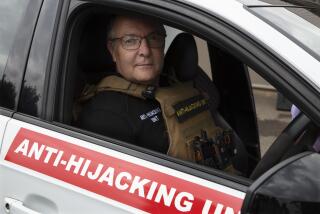U.N.’s Namibia Force to Use Once-Feared Armored Cars : S. Africa’s Casspirs: No Longer So Evil
- Share via
OSHAKATI, Namibia — For the last several years, South Africa’s hulking, pug-nosed armored cars called Casspirs have run the roads and plowed the bush of Ovamboland in the search for guerrillas of the South-West African People’s Organization (SWAPO).
To the South Africans, who invented it, the 11-ton vehicle, with its heavy firepower and sturdy protection against land mines, it is the ultimate weapon for counterinsurgency warfare.
To the local people, the Casspir is the embodiment of evil. They largely support SWAPO and they look upon the South Africans an an army of occupation.
‘Unfriendly Ghost’
Now, with the 23-year bush war supposedly at an end and Namibia preparing for independence from South Africa under U.N. supervision, a change of image may be in store for what one bumper sticker seen here calls “Casspir--an unfriendly ghost.”
U.N. police monitors assigned to watch the local security forces and report abuses of authority during the election campaign are preparing to acquire at least 10 Casspirs for their own use.
In U.N. livery--white paint with big black “U.N.” letters on the side--the armored cars will no longer instill the fear that many people say they felt whenever the army or police roared past, turrets bristling with machine guns.
Although various versions of the Casspir have been employed by regular and paramilitary forces in Ovamboland, its fearsome reputation stems mainly from the Koevoet, the counterinsurgency police made up of local black officers led by white South Africans.
Tough, Brutal Tactics
Koevoet--the name means “crowbar” in Afrikaans--is notorious for tough and often brutal tactics in prying out the SWAPO guerrillas infiltrating across the border from Angola.
Local people tell of terrorist raids, beatings and crop destructions in Koevoet’s campaign to crush SWAPO, and a few Koevoet members have been charged with murder.
Some of Koevoet’s Casspirs, actually a more powerful version called the Wolf Turbo, have been earmarked for the police monitors from the United Nations’ force operating out of Oshakati, the nerve center for U.N. operations in the region.
Peter Fitzgerald, a silver-haired Irishman on leave from his post as a Dublin police superintendent to serve as district commander of the U.N. contingent, calls the Casspirs “absolutely the most intimidating articles I have ever seen in my life.”
No Weapons on Board
He said it was necessary, however, for the U.N. Transition Assistance Group to have its own Casspirs in order to keep track of the local police, who continue to use them on bush patrols of up to seven days at a time. Unlike the police, the UNTAG vehicles will have no weapons on board.
Under U.N. Resolution 435, which spells out procedures for Namibia’s independence by early next year, Koevoet has already been integrated into the South-West African Police. However, the unit remains active and reports persist of Koevoet members continuing to badger residents who express pro-SWAPO sympathies.
U.N. officials at the operational level say proof of police abuse is hard to obtain, and UNTAG recently moved to double to 1,000 the number of monitors assigned as police watchdogs.
The sight of numerous police Casspirs in recent days with their 50-caliber machine guns still mounted also indicates that the police forces have not fully complied with a U.N. proviso for disarming the vehicles.
Not Clearly Defined
Fred Eckhard, a U.N. spokesman, said it was understood that the police would carry only small arms. While not clearly defined, he said, this was generally taken to mean nothing more than sidearms and semiautomatic rifles. Mounted machine guns would violate that understanding, he said.
Many South Africans see the Casspir as the proudest achievement of a home-grown arms industry springing out of a 1972 arms import embargo, imposed by the United Nations in response to the South African government’s refusal to abandon apartheid.
Military sources say that despite the embargo, South Africa now manufactures 95% of its own weapons and has become the world’s 10th largest arms exporter, with customers in 32 countries.
Casspirs have reportedly been put on display at international arms shows.
Tailored for Specific Tasks
The name Casspir is an acronym derived from the vehicles’ designers, the Council for Scientific Research, and the South African Police, for whom it was originally developed. Different versions are tailored for a specific task, carrying infantry into battle or urban riot control.
Its most innovative feature is a heavily armored, V-shaped underbody designed to deflect, rather than absorb, the blast of a land mine.
While SWAPO has periodically claimed to have damaged or destroyed the vehicles in the bush war, South African military sources say Casspirs that hit SWAPO-laid mines suffered only minor crew injuries and damage that was easily repaired.
More to Read
Sign up for Essential California
The most important California stories and recommendations in your inbox every morning.
You may occasionally receive promotional content from the Los Angeles Times.












